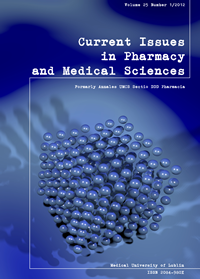Multiple sclerosis – causes, risk factors and symptoms of the disease - a literature review
DOI:
https://doi.org/10.12923/j.2084-980X/25.1/a.13Słowa kluczowe:
multiple sclerosis, causes, risk factors, symptomsAbstrakt
Multiple sclerosis (SM) is a classified chronic disease which leads to disability. Apart from severe cases, persons suffering from SM, live on average, as long as healthy people, however, their everyday life is often considerably difficult. SM usually occurs in young people. The first relapse normally happens between the age of 20 and 40. As a result of the pathologic process, myelin, i.e. the substance from which neuron sheaths are built, is damaged. The process disrupts normal impulse transmission along neural paths in the encephalon and the spinal cord. The causes of SM are unknown, despite broad knowledge of the mechanisms of impairments that occur in the course of the disease. The symptoms of SM can be transient and sometimes seem difficult to describe.
Bibliografia
1. Adamczyk K.: Pielęgniarstwo neurologiczne. Wydawnictwo Czelej, Lublin 60, 2000.
2. Bartosik-Psujek H. and Stelmasiak Z.: Stwardnienie rozsiane - trudne odpowiedzi na proste pytania. Neurologia i Neurochirurgia Polska 5, 443, 2006.
3. Członkowska A.: Stwardnienie rozsiane - współczesna diagnostyka i leczenie. Przewodnik Lekarza 1, 7, 2003.
4. Dworzańska E., Mitosek-Szewczyk E. and Stelmasiak Z.: Zespół zmęczenia w stwardnieniu rozsianym. Neurologia i Neurochirurgia Polska 1, 71–72, 2009.
5. Losy J.: Podstawy kliniczne chorób demielinizacyjnych - stwardnienie rozsiane. (w:) Jaracz K. and W. Kozubski: Pielęgniarstwo neurologiczne. Podręcznik dla studiów medycznych. Wydawnictwo Lekarskie PZWL, Warszawa 250-252, 2008.
6. Opara J., Jaracz K. and Brola W.: Aktualne możliwości oceny jakości życia w stwardnieniu rozsianym. Neurologia i Neurochirurgia Polska 4, 339, 2006.
7. Palasik W.: Stwardnienie rozsiane – nowe tendencje terapeutyczne. Przewodnik Lekarza 9, 41-42, 2007.
8. Papuć E., Belniak E. and Stelmasiak Z.: Zaburzenia depresyjne u chorych na stwardnienie rozsiane. Badania nad Schizofrenią 5, 466, 2004.
9. Pierzchała K. and Kubicka K.: Rola czynników środowiskowych w patogenezie stwardnienia rozsianego. Wiadomości lekarskie 1, 37-39, 2009.
10. Prusiński A.: Neurologia praktyczna. Wydawnictwo Lekarskie PZWL, Warszawa 311, 2001.
Pobrania
Opublikowane
Numer
Dział
Licencja
Prawa autorskie (c) 2012 Authors

Praca jest udostępniana na licencji Creative Commons Attribution-NonCommercial-NoDerivatives 3.0 Unported License.


